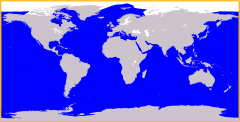
Back التوزع العالمي Arabic Kosmopolit növlər Azerbaijani Космополит (биология) Bulgarian Kosmopolitsko rasprostranjenje BS Cosmopolitisme (biologia) Catalan Kosmopolit Czech Kosmopolit (Biologie) German Kosmopolita distribuo (biologio) Esperanto Distribución cosmopolita Spanish Kosmopoliidid (bioloogia) Estonian
In biogeography, a cosmopolitan distribution is the range of a taxon that extends across most or all of the surface of the Earth, in appropriate habitats; most cosmopolitan species are known to be highly adaptable to a range of climatic and environmental conditions, though this is not always so. Killer whales (orcas) are among the most well-known cosmopolitan species on the planet, as they maintain several different resident and transient (migratory) populations in every major oceanic body on Earth, from the Arctic Circle to Antarctica and every coastal and open-water region in-between. Such a taxon (usually a species) is said to have a cosmopolitan distribution, or exhibit cosmopolitanism, as a species; another example, the rock dove (commonly referred to as a 'pigeon'), in addition to having been bred domestically for centuries, now occurs in most urban areas around the world.
The extreme opposite of a cosmopolitan species is an endemic (native) species, or one that is found only in a single geographical location. Endemism usually results in organisms with specific adaptations to one particular climate or region, and the species would likely face challenges if placed in a different environment. There are far more examples of endemic species than cosmopolitan species; one example being the snow leopard, a species found only in Central Asian mountain ranges, an environment to which the cats have adapted over millions of years.[1]
- ^ Z. Jack Tseng; Xiaoming Wang; Graham J. Slater; Gary T. Takeuchi; Qiang Li; Juan Liu; Guangpu Xie (2014). "Himalayan Fossils of the Oldest Known Pantherine Establish Ancient Origin of Big Cats". Proceedings: Biological Sciences. 281 (1774): 1–7. JSTOR 43600250.

